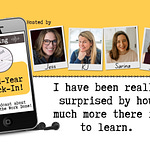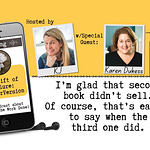This short outline thing is hard. It’s hard for one of two possible reasons: Either you don’t want to write an outline at all, bc “you know what you’re going to write” or you “hate outlining” or “don’t want to practically write it before I write it” OR you love outlining and could do it all day, to the tune of 17 pages all about what this is about and what it’s going to say and therefore “can’t possibly fit this onto 2 pages!”
Both of you, chill. It’s okay. You’re going to do this, and I suspect that you’ll end up liking it. The cool thing is that the thing that makes it easier—to either outline at all or to make a short outline as opposed to the monster some of us tend to create—is actually the same. (And don’t worry—there’s a place for those monster outline instincts. That’s called pre-writing, and we have a whole episode about it coming up in the fall.) Making outlines for fiction easier is all about where you start (try the end or the middle), and focusing on the emotions and tentpole events rather than on the plot.
In non-fiction, the same reluctance applies—especially if you think you know where you’re going or what you’re doing. Know your topic inside and out? Think you could “write this book in your sleep” because you write, lecture or teach about the subject all the time, or it’s your business? Do you have a list of things to cover chapter by chapter, or a particular memoir story to tell? Then you need an outline desperately. Trust me. Can you write this book without one? Yep. Will it be the book you want it to be? Almost certainly not, and I speak from experience. You, two, may be inclined to either gloss over this, or to want to write reams, going into detail about each area you intend to cover.
But doing either will get in your way. The path to a better book—one that has readers turning the pages of even a how-to in order to get to the next thing, or engrosses them in a chronological story of a thing they’ve never done and have no interest in doing—lies in getting this skeleton right. In non-fiction, that means finding a way to build interest and knowledge so that the reader constantly sees the need to follow you through to the end. In your outline, focus on the repeating themes and topics and the way those develop for the reader as they progress through the book.
Keeping it short forces you to look hard at what you’re building before you cover it with glitter and tinsel and helps you see and work on the flaws before they get baked in.
How to listen: if you’ve listened to any previous Bonus episodes or Minisodes, this one should already BE in your podcast feed. If not, click on the link to listen and you’ll find yourself at amwriting.substack.com. You COULD listen there, but we’re guessing you’d rather get all subscriber episodes, from now on, in your usual podcast-listening app. It’s easy, and you only have to do it once to get every #Minisode from now on right where you want it.
So click “listen in podcast app.” You’ll get an email with a link in it. Click the link—ON YOUR PHONE—and you will get a menu of the most popular podcast apps. Chose yours and click, and you’ll have a new “private” podcast feed for supporters only.
If your favorite listening app isn’t included, fear not. There’s an RSS link in the email. Your podcast app has a way to add that—it’s probably a “+” sign somewhere on your main page. Add the link once, and any time we do a #SupporterMini, you’ll get it without having to do a thing. (Trust us, it’s easy. This is WHY we chose Substack.)











